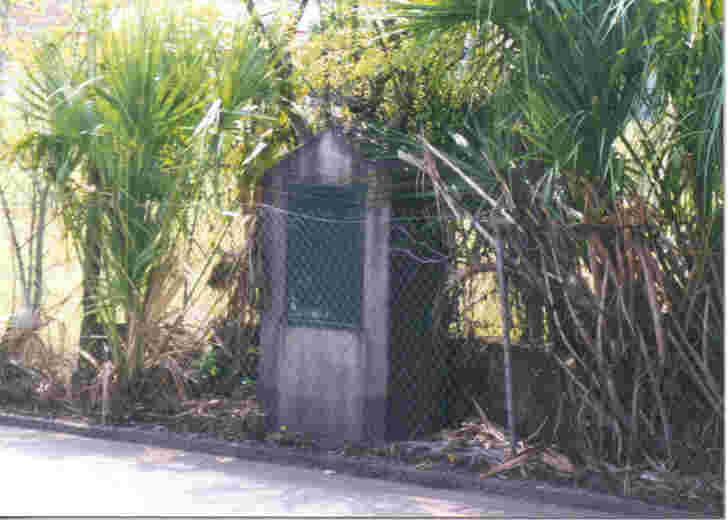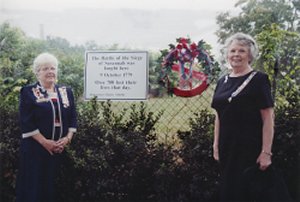|
|
Siege of Savannah
Marker Commemorating
The Siege of Savannah

This neglected and forgotten marker
sits on Louisville Road, just a few yards from MLK Blvd.
Across the street from the Savannah Visitors Center.
Bonaventure Chapter of the National Society of the Daughters
of the American Revolution has been granted a
"Beautification" lease by the Central of Georgia Railroad,
present owners of the property, in order that we might make
the marker more "Presentable". Beginning 22 May, 1999 and
continuing as the need persist and authorization to the
property remains we will work toward making the marker a
more fitting memorial to the Siege of Savannah and the many
men who died there.

Photo by Faye Dyess
Cleared, but not yet
presentable...

Photo by Faye Dyess
The first step in reclaiming the
marker is almost complete. The marker can now be seen.
Thanks are due to several of our members, their HODARS, and
Mr. William Hodges, HODAR of Frankie E. Hodges, and his
group of Sea Cadets. Mr. John Archer, HODAR of Lynn M.
Archer, spent the entire day chopping and sawing. Thanks to
everyone who helped.

Photo from Savannah Morning News
The Battle of
the Siege of Savannah
The Siege of Savannah occurred 9
October 1779. The site of this battle should be a honored
site. This battle was the second bloodiest battle of the
Revolution. More men died in battle only at Bunker Hill. The
hundreds that died there were buried in a mass grave at the
site. This battle marked the first time American and French
forces fought side by side. Two of the fallen heroes of this
battle are Sgt. William Jasper and Count Casimir
Pulaski.
Siege de
Savannah
"For fifty-five minutes in the early
dawn of October 9, 1779, there was fought on the then
western outskirts of Savannah what was unquestionably the
most sanguinary battle of the entire eight years of the
American War for independence...fought with a partly lifted
fog obscuring and hindering the movements of French and
American and helping to continue the confusion. In a single
hour there fell within an area of a few hundred square yards
more dead and wounded than are credited to any other
battlefield in the struggle for American independence.
(Thomas Gamble, Savannah Morning News, September 1,
1929)"
"This October 9th battle was fought on the present site
of the Savannah Visitor's Center at Martin L. King and
Liberty Streets; in 1779 it was called Spring Hill.
Vice-Admiral Charles-Henri d'Estaing had sailed from San
Domingo in the West Indies in August; his French troops had
been disembarked in September at Beaulieu Plantation on the
Vernon River, fourteen miles south of Savannah, and at
Bonaventure and Greenwich Plantations on St. Augustine Creek
near Thunderbolt, three and one-half miles east of Savannah.
When the invading French, who had been joined by American
militia, formed a half-circle around the British Savannah on
September 15, the French-American forces numbered about
5500. Within the city, the British forces were approximately
2630 of which 200 were armed Negros and 80 Creek and
Cherokee Indians. When the battle ended at Spring Hill that
October 9th morning, 333 British, French and American
soldiers and 32 officers were dead; 377 lay wounded. The
British had lost only three officers and fifteen soldiers.
The dead were buried in a mass grave probably on the site of
the present Savannah visitor's Center.
Bonaventure Plantation had been a captive of the
invading French since early September. Many of d'Estaing's
troops had come ashore suffering from scurvy and a stormy
crossing from San Domingo; rain and chilly weather had
caused fever to become common among the troops after they
landed. Two hundred soldiers and twelve officers were
hospitalized at Bonaventure Plantation unable to complete
the three and one-half mile trek to Savannah. Even before
the sounds of the French-American cannons reached
Bonaventure on September 20th, the women at the plantation
saw their home victimized by war.
Claudia Mullryne, her daughter Mary, and Mary's
children-John Mullryne, Josiah, and Claudia-were alone at
Bonaventure except for the plantation slaves. Colonel John
Mullryne, who had publicly declared his British allegiance
by oath in September, 1775, had left the plantation and gone
to Savannah as soon as the French arrived off Tybee
Island. Josiah Tattnall, Mary Mullryne's husband, had also
vowed his allegiance in 1775; he was in command of British
troops in Savannah. The Tattnalls had suffered an early loss
from the invasion; Fair Lawn, their two-storied dwelling in
Savannah, had been burned with all its outbuildings. In
fortifying the city, it was feared Fair Lawn would prove
advantageous to the advancing French-American forces.
Claudia and Mary waited; surrounded by French who knew the
Mullryne-Tattnall loyalty to King George III. The French
also knew that being loyal British subjects, the women had
inherited from the British Nation a prejudice against any
person of French descent. Claudia, Mary, and the Tattnall
children listened as the French cannons thundered at
Savannah from October 3rd through October 8th. Despite their
desecrated condition, they were more fortunate than the
women and children within the city; Count d'Estaing had
denied the British permission to evacuate anyone before or
during the six days the one thousand shells fell into the
besieged city.
After the October 9th battle, Count d'Estaing, wounded in
his arm and in the calf of his left leg, rode on horseback
to Greenwich Plantation. On October 7th, Jane Bowen, widow
of Samuel Bowen who built Greenwich, had written d'Estaing
informing him of her cooperation and requesting that she and
her fourteen year old daughter Elizabeth Ann be spared the
ravages that were imposed upon Bonaventure. Until October
9th, Greenwich had been headquarters for the French
officers, but 377 French and American wounded had to be
accommodated. This made it necessary to use Greenwich
despite Jane Bowen's protest.
The movement of the wounded from Spring Hill to Bonaventure
and Greenwich occurred without retaliation from the British.
In fact, the British loaned two carriages to convey the
wounded. many of these men probably never left the
hospitals; they lie in unknown graves on the grounds that
are Bonaventure and Greenwich Cemeteries.
The withdrawal of French troops began October 13th under the
direction of d'Estaing. The primary site of departure was
Causton's Bluff, north of Greenwich. County d'Estaing
commented that the troops returned aboard the vessels not
only without leaving anything behind, but more than that,
without being attacked, annoyed, or even followed. The
British seemed content enough that the French were
leaving.
In a letter dated October 17th, Governor James Wright
reported that the volunteer Chasseurs, a brigade of 545
Black and Mullato troops of San Domingo, had departed from
Bonaventure. The French withdrawal was not completed until
October 21st, and even then not all the French were aboard
the departing ships. Contrary to d'Estaing's statement
"without leaving anything behind", in addition to the men
who had deserted during the 24 preceding days, there were
also those who simply got lost in confusion of
departure.
The Mullrynes and Tattnalls survived this encounter with the
American revolt to free Savannah from the British.
Bonaventure, though damaged and pillaged, was repaired, the
terraced gardens refurbished, but the graves of the unknown
French soldiers were a constant reminder of the accelerating
political turmoil. By the summer of 1782, the Mullrynes and
Tattnalls were forced to leave Bonaventure as the tide of
Americanism swept them out of the colony; the Mullrynes to
New Providence, Nassau, in the Bahamas; the Tattnalls to
London, England.
Ironically, Count d'Estaing fell victim to the political
revolution in his own France. Called as a character witness
for Marie Antoinette during the French Revolution, he was
condemned to death and beheaded on April 28, 1782. The
sixty-four year old nobleman is supposed to have remarked
when the sentence was pronounced, "When you cut off my head,
send it to the English; they will pay you well for it!"
This quotation was
taken from "Friends of Bonaventure, Commemorative
Issue-October 1779, October 13, 1996" by Mr. Terry Shaw,
Chairman, and used with his permission.

Chapter Regent Faye Dyess
and Secretary Dory Hickson of Bonaventure Chapter, NSDAR, at
the 2003 commemoration of the Siege of Savannah.
(photo
by Lynn Wright)

© 1998
|